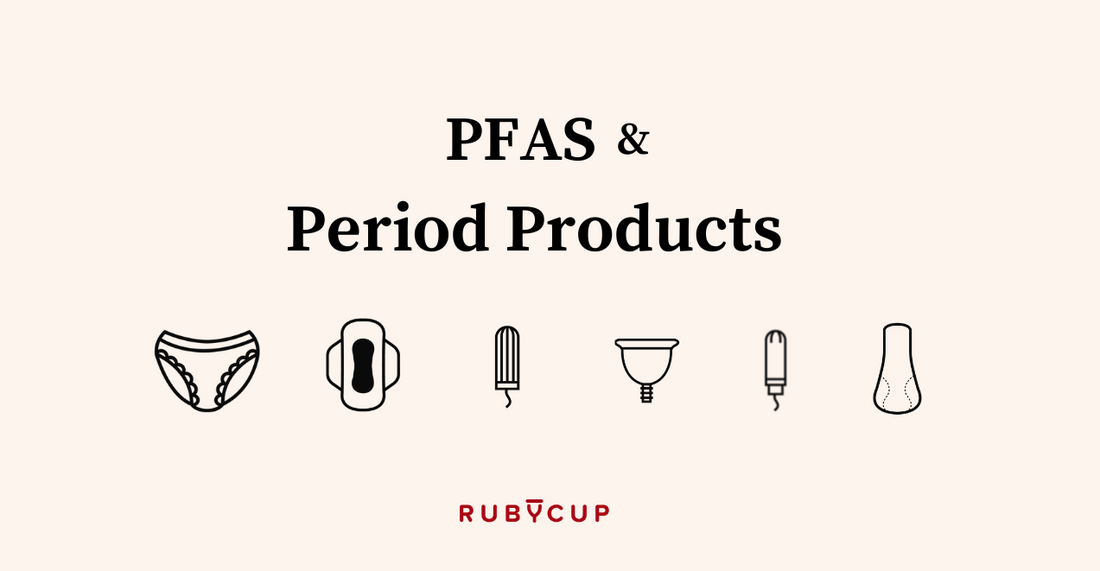This article is written by clinician Amy Harris. Read more about Amy Harris at the end of the article.
Pop quiz – Would you expect to find toxic chemicals in your period panties? You probably answered no, because slick branding, marketing, and advertising campaigns have convinced you that paying more for reusable, washable menstrual underwear such as Thinx, Knix, or Saalt was a safe and healthy choice for your body and the environment.
Unfortunately, you are wrong, and so was Thinx, who settled a class action suit in January 2023 after being accused of misleading consumers about the health benefits or safety of their underwear. Ruby Cup believes that consumers of all period products have a right to know what potentially harmful chemicals could be inside. Keep reading to become better informed about PFAS in period products.
What are PFAS?
PFAS (pronounced pee-fahs) are more than one thousand varieties of toxic fluorinated chemicals. PFAS stands for per- and polyfluoroalkyl substances- uniquely strong “forever” chemicals formed from unbreakable bonds between chlorine and fluoride. People sometimes call PFAS forever chemicals because they break down so slowly.
PFAS help extend the shelf-life of many commonly-used products (like fast-food wrappers) and boost repellency. Repellency is how well something repels oil, grease, heat, corrosion, or water (like the fabric of a waterproof rain jacket). In addition, common household products like non-stick pans and stain-repellent carpets and furniture contain PFAS.
Why are PFAS in period products?
PFAS's repellency makes them a top pick for period products, especially reusable period panties. PFAS enhance the performance and durability of the underwear, allowing it to be moisture-wicking and leak-resistant.
Earth-huggers with periods were thrilled to be able to wash and reuse their period panties. But, unfortunately, to maintain their moisture-wicking and stain-resistant absorbent qualities through multiple washes, period panty manufacturers chose to add PFAS, thus putting the planet’s and menstruators’ health at risk.
Why are we just hearing about PFAS in period underwear now?
Sierra magazine published the results of a collaborative investigation with a Notre Dame researcher in January 2020, finding PFAS chemicals in the crotch area of Thinx underwear. Later that year, three separate lawsuits filed against Thinx alleged more third-party evidence of PFAS and other toxic chemicals in their period underwear.
Thinx denies any wrongdoing and has not admitted to using PFAS in its manufacturing processes. The company refutes misleading consumers by claiming that its period panties offered people a “safe, healthy, organic, and sustainable choice for women.”
In January 2023, the company agreed to pay $5 million to people who purchased their products. The Thinx lawsuit raised awareness about the potential for toxic chemicals in period products. But, unfortunately, it is most likely only a canary in the coal mine of countless other personal care products laced with PFAS.
PFAS are not only in period pants
Similar consumer and scientific reports show that multiple brands of tampons, pads, and menstrual underwear could all be contaminated with PFAS or other potentially harmful chemicals. Other toxic substances in menstrual products (one study found more than 24) are parabens, phthalates, bisphenols, and triclocarban. In addition, scientists analyzing menstrual blood samples consistently find phenols, parabens, phthalates, and organochlorines.

These chemicals have been shown to disrupt our endocrine symptoms (our body’s hormonal communication system) and be toxic to reproductive health. The fact that they are in menstrual blood means they are also in the uterine lining, where an embryo might implant. So even if you are not worried about future pregnancies right now, when you flush your menstrual blood down the toilet or toss a tampon or pad in the trash, you are dumping these toxic chemicals into the ecosystem.
How are PFAS harmful to your health?
Multiple peer-reviewed scientific studies have shown that exposure to PFAS can:
- - Suppress your immune system, including making vaccines less effective
- - Increase your risk for some cancers (prostate, kidney, and testicular)
- - Increase your risk for obesity
- - Increase your risk for high cholesterol levels
- - Cause thyroid disorders
Regarding women’s health, PFAS are heavy hitters because they are so-called endocrine disrupters that are toxic to the reproductive system. They can:
- - Decrease fertility (make it harder to get pregnant)
- - Increase your risk for high blood pressure in pregnancy
- - Cause babies to be born smaller (low birth weight)
- - Make breastfeeding harder by impacting breast tissue development
- - Put children at greater risk for developmental and behavioral delays, premature puberty, and bone development problems
- - Reduce sperm count in male offspring
PFAS never break down or do so very slowly. Instead, they build up in people, animals, and the environment over time. As a result, we are exposed in multiple ways, day in and day out, for our entire lifetimes to PFAS. Even if the water we drink, the air we breathe, the fast food we eat, and the period panties we wear expose us to very low amounts of PFAS, the cumulative total exposure puts our health at risk.
How do PFAS in period products get into your body?
What makes exposure to toxic substances through menstrual products a big deal is that pads, tampons, cups, and panties all come into contact with some of the most sensitive and absorptive skin on people with vaginas and vulvas. The vagina’s thin skin and abundant blood supply close to the surface allow it to easily and quickly absorb chemicals into the bloodstream. Healthcare providers choose to administer estrogen through a cream or suppository inserted into the vagina vs. taken as a pill because when administered vaginally, the estrogen levels can be 10-80 times higher than when administered orally.
This rapid absorption is good news for people wanting quick treatment for vaginal dryness, but bad news when talking about the absorption of toxic chemicals like PFAS through your vaginal tissues to the rest of your body.
For those of you wondering, you can absorb chemicals and substances through your vulva alone. The vulva is the skin and tissue on the outside of the vagina that would come in contact with chemical-laden period panties or pads.
The second risky part of period products is the length of time people are exposed to these chemicals. The duration of your exposure to PFAS from period products depends on how long you spend menstruating in your lifetime, determined by:
- - What type of birth control (if any) you use
- - The number of pregnancies you have
- - Menarche (how old you are when you get your period for the first time)
- - Menopause (how old you are when you stop having your period).
It is estimated that the average menstruator will use 10,000 menstrual products over a lifetime. You can use Ruby Cup’s Menstrual Cup Impact Calculator to get a personalized total of how many products you’ll use in your lifetime. That is what environmental scientists call a chronic exposure, especially when you consider that PFAS are designed to stick around, so they accumulate over your lifetime of periods.
The age of menarche is the third component of PFAS in period products’ triple threat: people start using period products at a young age (as young as 9, but the average age when people start menstruating is 12-12.5 years old). Period panties are explicitly marketed to younger girls and tweens as a gateway period product – a kinder, less intimidating introduction to the world of tampons, super pads with wings, or menstrual cups. But girls’ reproductive and hormonal communication systems are still vulnerable to dysregulation and harm at these young ages. Add in some “forever chemicals” known to disrupt those hormones and settle into the egg cells (oocytes) in the ovaries, and you have a recipe for generational reproductive harm.
How can you limit your exposure to PFAS?
Unfortunately, you are likely already exposed to PFAS in many different ways. There are PFAS in the water, soil, air, and food you drink, eat, breathe, or ingest. Humans have used PFAS in many products and factories for over eighty years.
The ubiquitous nature of PFAS in our environment makes it impossible to avoid PFAS altogether. But there are small lifestyle switches to make that may help limit your exposure over time. For example, food packaging like grease-resistant paper, fast food containers, microwave popcorn bags, pizza boxes, and candy wrappers can all contain PFAS. Research has shown that PFAS migrate from wrappers or packaging into the food you eat, especially if it is salty, fatty, or acidic – people who eat out more often have even been shown to have higher levels of PFAS in their bodies.
Becoming a conscious consumer of foods and other items can help limit exposure. You will also send manufacturers a message that consumers want environmentally-friendly, sustainable, non-toxic alternatives. Some PFAS-limiting lifestyle decisions are:
- - Consider switching to a 100% silicone menstrual cup like Ruby Cup.
- - Buy one – give one. Give women worldwide safer, healthier period products by purchasing from Ruby Cup or menstrual cup makers with charitable donation programs.
- - Eat more fresh food and less take-out or pre-packaged foods.
- - Filter your drinking water with an activated carbon or reverse osmosis filtration system.
- - Choose cookware made of cast iron, stainless steel, glass, or enamel instead of Teflon.
- - Avoid microwave popcorn and greasy foods wrapped in paper.
- - Look for uncoated nylon or silk dental floss or coated in natural wax.

Graphic/image: Tampa Bay Water
You can also become an advocate for change, using the power of your voice and pen to demand bans on the use of PFAS in period products, consumer goods, and manufacturing. Some opportunities for action could be to:
- - Write, email, or call product manufacturers, the U.S. EPA, FDA, and the European Chemical Association (ECHA), to demand testing of period products for known toxic chemicals, including PFAS.
- - Ask your elected officials to support restrictions on PFAS in consumer products and remediation of contaminated sites.
Are there safe level of PFAS in period products?
Many scientists, public health advocates, and environmentalists would argue that there is no safe level of PFAS chemicals. Because of their permanence, they advocate for a complete ban on PFAS. It can take four to 15 years for levels of PFAS to reduce by half in the human body, and it can take centuries for the substances to disappear from the environment. A complete ban would stop any new chemicals from being added to the already toxic levels built up in our bodies and on our planet. Unfortunately, we don’t yet know how to destroy accumulated PFAS, to clean them from the earth, or remove them from our bodies. Until environmentalists and scientists develop that technology, you will be safest and healthiest if you can minimize your PFAS exposure. Switching to a period cup like Ruby Cup is one small way to limit the amount of PFAS in your body and on this Earth. At Ruby Cup, our mission is to bring you better menstrual health solutions, one menstrual cup at a time.
FAQs
- Do Ruby Cups contain PFAS?
No. Ruby Cups are made from 100% pure medical-grade silicone. The silicone material is hypoallergenic, non-absorbent, and contains no harmful additives or chemicals.
- Are PFAS used in the production of Ruby Cup menstrual cups?
No.
- Aren’t PFAS being phased out by manufacturers?
Yes, but not quickly enough and not universally. Over the past few decades, global manufacturers have replaced certain PFASs with other PFASs or fluorine-free substances.
Scientists and governments worldwide who first recognized the harmful effects of some PFASs were the driving force behind these regulations and innovations. ECHA recently banned using all PFAS-containing fire-fighting foams, and five EU countries have proposed restricting PFAS use in other situations. At this point, there are no specific regulations in the EU or US banning the use of PFAS in period products.
Sources
* Chong-Jing G, Kurunthachalam K. Phthalates, bisphenols, parabens, and triclocarban in feminine hygiene products from the United States and their implications for human exposure.
Environment International. 2020;136.105465. https://doi.org/10.1016/j.envint.2020.105465.
* Choy, J. My menstrual underwear has toxic chemicals in it. Sierra Magazine. Published January 7, 2020. Accessed February 5, 2023. https://www.sierraclub.org/sierra/ask-ms-green/my-menstrual-underwear-has-toxic-chemicals-it
* Per- and polyfluoroalkyl substances (PFASs). European Chemical Agency (ECHA).
Accessed February 7, 2023. https://echa.europa.eu/hot-topics/perfluoroalkyl-chemicals-pfas
* PFAS explained. United States Environmental Protection Agency (EPA). Published March 16, 2022. Accessed February 5, 2023. https://www.epa.gov/pfas/pfas-explained
* PFAS and Reproductive and Developmental Toxicity. Environmental Working Group. Published September 2019. Accessed February 7, 2023. https://www.ewg.org/sites/default/files/u352/EWG_PFAS_Toxicity_C02.pdf
* Silva EL, Walker DI, Coates Fuentes Z, et al. Untargeted metabolomics reveals that multiple reproductive toxicants are present at the endometrium. Sci Total Environ. 2022;843:157005. doi:10.1016/j.scitotenv.2022.157005
Upson, K., Shearston, J.A. & Kioumourtzoglou, MA. Menstrual Products as a Source of Environmental Chemical Exposure: A Review from the Epidemiologic Perspective. Curr Envir Health Rpt 9, 38–52 (2022). https://doi.org/10.1007/s40572-022-00331-1
https://echa.europa.eu/hot-topics/perfluoroalkyl-chemicals-pfas
Written by Amy Harris.
Amy Harris is a certified nurse-midwife with more than a decade of clinical experience in reproductive health clinics, hospitals, and private OB/GYN practices. Amy holds a Masters of Science in Maternal and Child Health from Harvard School of Public Health and completed her nursing and midwifery training at Yale School of Nursing and Boston University School of Public Health. Passionate about empowering women through health education, Amy puts her public health training to work as a dedicated women’s health writer.
 Your Account
Einloggen
Your Account
Einloggen
 Basket
Basket



